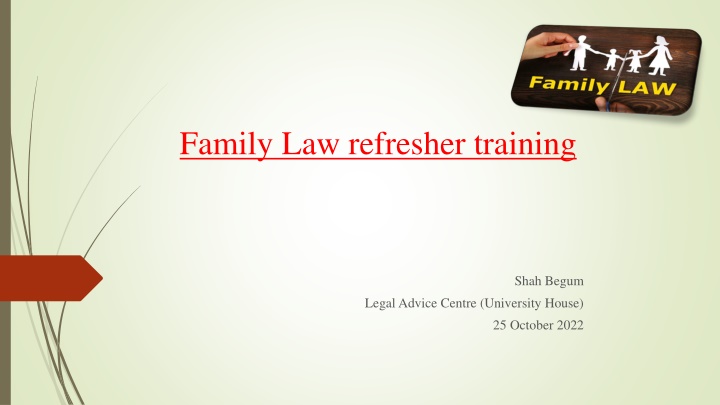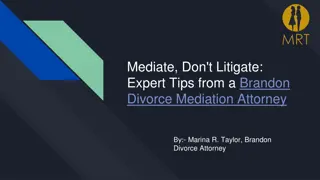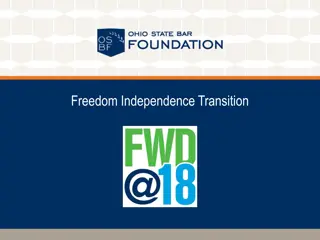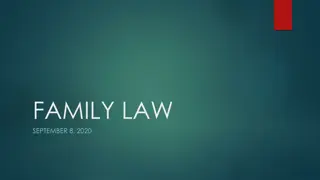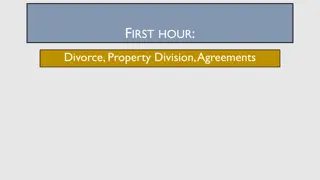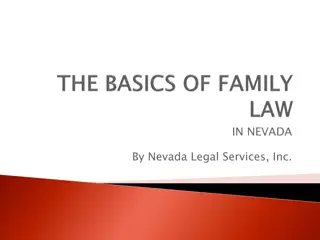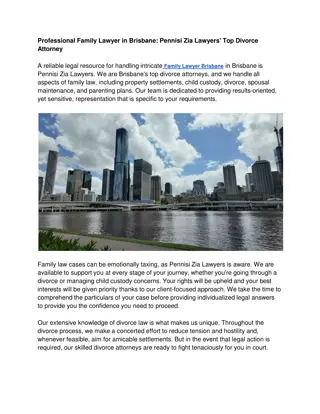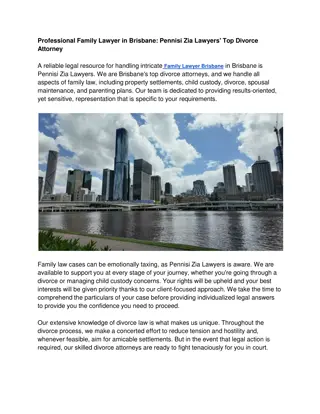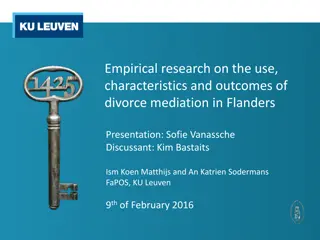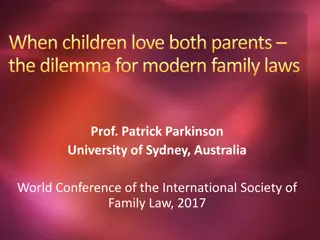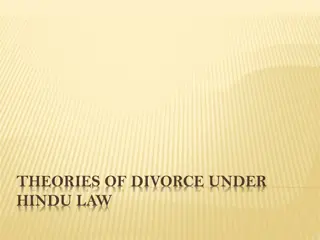Family Law Refresher Training: Divorce and Legal Procedures Overview
This refresher training session focuses on key aspects of family law, specifically divorce proceedings, financial remedy orders, and child arrangements orders. It covers important topics such as how to apply for a divorce, eligibility criteria, visa implications post-divorce, and fee assistance options for applicants. The session offers valuable insights for legal professionals and individuals navigating family law matters.
Download Presentation

Please find below an Image/Link to download the presentation.
The content on the website is provided AS IS for your information and personal use only. It may not be sold, licensed, or shared on other websites without obtaining consent from the author.If you encounter any issues during the download, it is possible that the publisher has removed the file from their server.
You are allowed to download the files provided on this website for personal or commercial use, subject to the condition that they are used lawfully. All files are the property of their respective owners.
The content on the website is provided AS IS for your information and personal use only. It may not be sold, licensed, or shared on other websites without obtaining consent from the author.
E N D
Presentation Transcript
Family Law refresher training Shah Begum Legal Advice Centre (University House) 25 October 2022
This session will cover: Divorce and divorce proceedings Financial Remedy Orders Child Arrangements orders (CAO)
How do you apply for a divorce? An application should be made using form D8. Applications can be made on paper or online. The application must be accompanied by: Original Marriage (civil partnership) certificate or a certified copy (and a certified translation if it is not in English); Reconciliation statement (where there is a solicitor acting) (Form D6); and The court fee (see Civil and Family Court Fees EX50) which is currently 593, or fee exempt form.
Help with fees form The client should consult the information contained within form EX50 entitled Civil and Family Court Fees for the precise court fee specific to their application. If a client is in receipt of low income or state benefit, having less than the allowable limit existing at the time in savings and investments, it may be the case that they are permitted to apply for an exemption or fee remission from the Court fee. The client should peruse form EX160A entitled, Guide - How to apply for help with fees for more information. The Court does make allowances for each dependent child. If the client believes they qualify for an exemption of the Court fees they should complete Form EX160 entitled, Apply for help with fees .
Who can apply for a divorce? You can get divorced in England or Wales if all of the following are true: You have been married for over a year; the relationship has permanently broken down; your marriage is legally recognised in the UK; and the UK is your permanent home, or the permanent home of your husband or wife.
Your visa status when you divorce If either party is in the UK as a dependant on their partner s visa, they will lose their visa status once their divorce is made final. They will need to check whether they can stay in the UK long term. They might need to apply for a new visa if they get divorced. If they do not have the right to stay in the UK they might have to leave.
1. Check if you can get a divorce To file for divorce your marriage must have irretrievably broken down. Applicants do not have to establish one or more of the five available reasons under the old divorce rules. On 6 April 2022 changes to the legislation on divorce came into force. Changes to divorce law The Divorce, Dissolution and Separation Act 2020 reforms the legal requirements and process for divorce. The act aims to reduce the potential for conflict amongst divorcing couples by: removing the ability to make allegations about the conduct of a spouse allowing couples to end their marriage jointly The act also introduces a minimum period of 20 weeks between the start of proceedings and application for conditional order (the Decree Nissi). This provides couples with a meaningful period of reflection and the chance to reconsider. Where divorce is inevitable, it enables couples to cooperate and plan for the future. It will no longer be possible to contest a divorce, except on limited grounds including jurisdiction.
2. File the divorce petition This is where you apply to the court for a decree of divorce. You will no longer need to provide information to support the reasons given for the irretrievable breakdown of your relationship. You can apply at gov.uk/apply-for-divorce. You will notice that the application form is more straightforward.
3. The Court issues the divorce petition Your application for divorce will be checked and if the information is correct you ll receive confirmation that is has been issued together with a copy of your completed divorce petition.
4. The respondent receives a notification Your husband or wife (the respondent ) will be notified of the divorce petition and will receive an invitation via email or post to complete the response (known as the acknowledgement of service) which they should do within 14 days.
If the parties applied jointly The application will be checked. If it s correct, they ll both be sent: a notice that the application has been issued (sent out) a copy of your application stamped by HM Courts and Tribunals Service (HMCTS) an acknowledge receipt a case number They need to wait 20 weeks. After this time the Applicant or both parties can continue with the divorce by applying for a conditional order.
If the client applied as a sole applicant Their application will be checked. If it s correct, they ll be sent: a notice that the application has been issued (sent out) a copy of your application stamped by HMCTS a case number The court will send the Respondent the divorce application and an acknowledgement of service notification. The Respondent must respond to the acknowledgement of service notification within 14 days saying whether they: agree with the divorce intend to dispute the divorce If the Respondent does not respond the court will tell the Applicant what they need to do. They will not need to go to court.
If they agree with the divorce If they dispute the divorce You can continue with the divorce by applying for a conditional order (or a decree nisi if the court issued your divorce application before 6 April 2022). Your husband or wife will have to complete an answer form to say why they disagree with the divorce. Your husband or wife must have a genuine legal reason to dispute the divorce. They cannot dispute the divorce simply because they do not want a divorce or to delay the process. You may have to go to court to discuss the case. You will need to wait 20 weeks before you can apply for a conditional order or decree nisi. If they do not submit an answer form, you can continue the divorce by applying for a conditional order (or a decree nisi if the court issued your divorce application before 6 April 2022).
5. Apply for a Conditional Order You will receive an email confirmation or letter informing you when you can proceed to the next step. You can then apply for a Conditional Order (previously referred to as Decree Nisi ) online by logging into your account or by completing and submitting the D84 form by post. A conditional order and decree nisi are documents that say that the court does not see any reason why you cannot divorce.
6. Receive a Decree Nisi date If the court issued your divorce application before 6 April 2022 If you applied for a divorce online, you can apply for a decree nisi online. To apply by post, fill in the application for a decree nisi. You also need to fill in a statement confirming what you said in your divorce application is true. There are 5 statement forms - use the one that covers the reason you ve given for your divorce. Attach a copy of your husband s or wife s response to the divorce application. If your Decree Nisi Application is approved, the court will send you and your husband or wife a certificate of entitlement to a decree . This will tell you the time and date when you ll be granted the Decree Nisi. You should note that you remain legally married because the Decree Nisi is only an interim decree of divorce. You need to wait at least six weeks after the Decree Nisi is granted before you can apply for a Decree Absolute to finalise the divorce. You will receive an email on how to apply online.
If the court issued your divorce application on or after 6 April 2022 If you applied for a divorce online, you ll be told how to apply for a conditional order online. To apply by post, fill in the application for a conditional order. You must wait 20 weeks after your divorce application has been issued before applying for a conditional order. You can apply for a conditional order and continue with the divorce as a sole applicant, even if you started the divorce process jointly with your husband or wife.
If the judge agrees, the court will send you and your husband or wife a certificate. This may take several weeks. The certificate will tell you the time and date you ll be granted a conditional order or decree nisi. You will still be married after it has been granted. You ll have to wait 43 days (6 weeks and 1 day) before you can apply to finalise the divorce and end the marriage. Finalise your divorce To end your marriage you must apply for either: a final order a decree absolute - if the court issued your divorce application before 6 April 2022 You need to wait at least 43 days (6 weeks and 1 day) after the date of the conditional order or decree nisi before you can apply to end your marriage. You can apply for a final order as a sole applicant, even if you started the divorce process jointly with your husband or wife. Apply within 12 months of getting the conditional order or decree nisi - otherwise you will have to explain the delay to the court.
Financial Remedy Order Applications and Transfer of Tenancy Orders
What is a Financial Remedy Order? Financial remedy proceedings, which are now known as a financial remedy order, helps to settle the financial dispute between divorcing couples in court if they have been unable to resolve things during mediation. A financial remedy order can include lump sum payments, shares of pensions, ownerships of a property and regular payments for childcare and other needs.
The contents of a financial remedy order will depend upon the financial position of the couple in question. Some orders may be very complicated, whereas others may be very straightforward. A financial remedy order will commonly include: 1. Property adjustment order this is an order in connection with property. For example, a property adjustment order may provide for a sale or transfer of property. 2. Pension orders this may include a pension sharing order or alternatively, a pension attachment order. 3. Periodical payments orders this is an order for either spousal or child maintenance. 4. Clean break order this is an order effectively confirming that there is a clean break, i.e., that the court is not making any order in relation to a particular asset. The court has extremely wide powers on divorce or dissolution of a civil
What will the court take into consideration? In deciding what an appropriate financial remedy order the court should make, the court will take into account all the circumstances of the case. The court s primary consideration will be the welfare of any children under the age of 18. In addition to this, the court will consider the factors set out at section 25 of the Matrimonial Causes Act 1973 (in the event of divorce) and Schedule 5, Part 5, paragraph 21 of the Civil PartnershipAct 2004 (in the event of dissolution). The factors are as follows: a) the income, earning capacity, property and other financial resources which each of the parties to the marriage/ civil partnership has or is likely to have in the foreseeable future, including in the case of earning capacity any increase in that capacity which it would in the opinion of the court be reasonable to expect a party to the marriage/ civil partnership to take steps to acquire; b) the financial needs, obligations and responsibilities which each of the parties to the marriage has or is likely to have in the foreseeable future; c) the standard of living enjoyed by the family before the breakdown of the marriage/ civil partnership; d) the age of each party to the marriage and the duration of the marriage/ civil partnership; e) any physical or mental disability of either of the parties to the marriage/ civil partnership; f) the contributions which each of the parties has made or is likely in the foreseeable future to make to the welfare of the family, including any contribution by looking after the home or caring for the family; g) the conduct of each of the parties, if that conduct is such that it would in the opinion of the court be inequitable to disregard it; h) the value to each of the parties to the marriage/ civil partnership of any benefit which, by reason of the dissolution or annulment of the marriage/ civil partnership, that party will lose the chance of acquiring.
Pre-court procedure Prior to issuing an application for a financial remedy order it is first necessary to consider whether there is any prospect of resolving the matter out of court. There is a requirement for a couple who wish to engage in court proceedings to first attend a Mediation Information and an Assessment Meeting (MIAM). However, mediation is not appropriate in every case. Once a MIAM has been attended you would then prepare Form A which is the application for a financial remedy order. The relevant court fee will need to be paid or a help with fees application form can be filed.
The first appointment Once your Form A has been issued a few weeks thereafter, you will receive the Notice of First Appointment. This document will set out the steps that will need to be taken before the first court hearing which is known as the first appointment. In advance of the first appointment, the first step to take will be to complete a Form E which is a document that sets out each person s assets, liabilities, income, outgoings and other relevant financial considerations. Those Forms E are then exchanged between the parties. Consequently, each person will then prepare various other documents in readiness for the first court hearing. This will include a questionnaire of any requests for further information, a Chronology (detailing the relevant dates in the Marriage) and the Statement of Issues. This usually needs to be 14 days before the First Appointment and is served upon the other party.
If agreement is not reached at the First Appointment, the judge will set a Financial Dispute Resolution Hearing (FDR Hearing). At this hearing, the judge may say what they think would be a reasonable financial settlement and further negotiations will proceed. If you are able to come to an agreement during this hearing, the judge will approve it and a Consent Order can be made. If agreement is not reached at the FDR Hearing, the judge will set a Final Hearing. At this hearing, the judge will make a final decision about how finances should be arranged and will make a Financial Remedy Order.
Transfer of Tenancy Orders If one spouse is entitled, either in their own right or jointly with the other spouse, to occupy a dwelling house by virtue of a relevant tenancy, the court may make a transfer of tenancy order on granting a decree of divorce, a decree of nullity of marriage or a decree of judicial separation or at any time thereafter (whether, in the case of a decree of divorce or nullity of marriage, before or after the decree is made absolute). The power to transfer the tenancy to a former spouse arises on decree nisi and the order becomes effective on decree absolute. If, however, either spouse remarries that spouse will not be entitled to apply for a transfer of tenancy order. If one spouse remarries, that spouse might be able to apply for a transfer of tenancy order under the Children Act.
Matrimonial CausesAct A tenancy can be transferred under the Matrimonial Causes Act 1973 by applying for a property adjustment order in conjunction with divorce, judicial separation, dissolution of a civil partnership or nullity proceedings. ChildrenAct Under the Matrimonial Causes Act/Family Law Act, tenancy transfers can only be made in conjunction with divorce, nullity or judicial review proceedings. Married couples or civil partners with children who are not divorcing may need to use the Children Act provisions instead. Applications can also be made under the Children Act after the marriage or civil partnership has ended, as long as the tenancy is still in existence. Under the Children Act, the court can order a tenancy to be transferred to a child or to the parent or guardian caring for the child if it is for the benefit of a child (or children) of the relationship.
Procedure An application for the transfer of a tenancy under FLA 1996, s 53 is made in Form D50B. A sworn statement in support should be filed along with the relevant court fee or the help with fees form. The statement should confirm the applicant's eligibility to apply, that the tenancy is a relevant tenancy, and that one or both of the parties, as the case may be, is entitled to occupy the property by reason of the tenancy. The criteria on which the court will exercise its discretion should also be addressed. The court will serve the application, unless it specifically directs the applicant to do so. Such service must be on both the respondent and the landlord. The landlord may exercise their right to be joined as a party. On the making of a transfer of tenancy order, the court has additional powers to grant compensation between the parties, including the sharing of liabilities for the dwelling- house until the date ordered for the transfer.
A child arrangements order is a court order that specifies matters such as with whom a child is to live and when. It may alternatively, or also, set out with whom a child is to have contact with and when, and what form that contact should take. A judge decides such matters, although the child s wishes and feelings are sought (subject to their age and understanding) as well as those of their parents and others, and expert evidence may also be sought. If a child arrangement order is not complied with, then there are sanctions that can be taken if there was no reasonable excuse not to comply with it.
The age of the child A child arrangements order concerning contact or residence can only be made if the child concerned is under 16 years of age, unless the court is satisfied that the circumstances of the case are exceptional. However, an existing order can be varied or discharged by a court when a child has turned 16. A child arrangements order cannot be made once the child concerned turns 16 years of age, unless, similarly, the circumstances of the case are exceptional . However, this does not apply if the arrangements regulated by the order relate only to either with whom the child concerned is to live, or when the child is to live with any person (or both).
Circumstances of the child There are a number of circumstances when a court is unable to make a child arrangements order: if the child is in the care of a local authority pursuant to a care order; if the order is in favour of a local authority (and no local authority can apply for such an order); anyone who is or was (within the last six months) a local authority foster parent caring for a child unless they have the consent of the authority, or, they are a relative of the child, or the child concerned has lived with him for at least one year preceding the application.
Before an application can be made to the Family Court for a child arrangements order, the parties must have attended at least one mediation session (unless an exemption applies). If the case is not suitable for mediation or it cannot progress the mediator will confirm this to allow the applicant to carry on and apply to the court.
Children Law and Practice notes that when a court which is considering making, varying or discharging a child arrangements order, including making any directions or conditions which may be attached to such an order, it must have regard to the following principles: the paramountcy of the child s welfare; that delay in determining the question is likely to prejudice the welfare of the child; the presumption in favour of parental involvement; the welfare check-list; the presumption against making an order unless to do so would be better for the child than making no order at all.
Who can apply The child s mother, father or anyone with parental responsibility can apply for a court order. Other people, like grandparents, can apply for these court orders, but they will need to get permission from the courts first.
How to apply Fill in the C100 court form. The parties must show they have attended a meeting about mediation first - except in certain cases (there has been domestic abuse, for example). Send the original form and 3 copies of it to the nearest court that deals with cases involving children. The C100 form may be processed faster if it is submitted online or by email. It costs 232 to apply for a court order. The party applying may be able to get help with court fees if the person is on benefits or a low income.
First hearing The court will arrange a directions hearing with both parents. There will usually be a family court adviser from the Children and Family Court Advisory and Support Service (CAFCASS) at the hearing. Parties should receive a phone call from CAFCASS. At the hearing, a judge or magistrate will try to work out: what you can agree what you cannot agree if your child is at risk in any way They ll encourage you to reach an agreement if it s in the child s best interests. If you can, and there are no concerns about the child s welfare, the judge or magistrate can end the process. The court will make a consent order which sets out what the parties agreed, if necessary.
CAFCASS will want to talk about any safeguarding concerns either party may have. They will also ask about what each party hopes to achieve from the proceedings. The investigations and conversations will form the basis of CAFCASS preliminary report to the Court for the 1st hearing.
The judge or magistrate will set a timetable for what happens next. They may ask the parties to try again to reach an agreement, for example by going to a meeting with a mediator. The parties may have to go on a course if your case is about child arrangements. The course is called a Separated Parents Information Programme , and could help the parties find a way to make child arrangements work. The parties usually have to go to one or 2 meetings, depending on the type of programme. The parties will not be at the same meetings. If the parties reach an agreement at any stage, the judge or magistrate can stop the process.
Domestic Abuse allegations If there are domestic abuse allegations that are denied then the Court should deal with this first and so is likely to direct both parties to file and serve statements dealing with the allegations and for there to be prepared a Schedule of Allegations.
Fact-finding hearing The court will fix a fact finding hearing once the statements and the Schedule are completed and when any documents from the police have been received. Usually both parties will have to give evidence so often these hearings last half a day or a day. Once the Court has decided what happened in the past at any fact finding hearing and any recommendations from CAFCASS have been received the case will be listed for a Dispute Resolution Appointment (DRA). This is to try to narrow issues if possible and see if an agreement is possible. The Court can hear evidence if necessary. If there is no agreement the Court will fix a date for a final hearing.
Final hearing In preparation for a final hearing the applicant will be expected to prepare an agreed, paginated and indexed bundle for use by the parties and the court. This will include all the papers and statements along with an up to date case summary, a chronology and a position statement. At the final hearing both parties will give their evidence and challenge the other persons evidence in cross examination. The Judge will then make an Order taking into account the Welfare Checklist.
The Judges will always put the welfare of children first. They will think about the: child s wishes and feelings child s physical, emotional and educational needs effect any changes may have on the child child s age, gender, characteristics and background possible risk of harm to the child ability of parents to meet the child s needs orders the court has the power to make
If you want to change your application The parties should use form C2 to change an application that the court is still considering. The fee depends on what the parties are asking the court to do. Court fees: 167 if the parties still want the court to decide your case through a court hearing 53 if the parties have agreed and they want the court to approve their consent order without a court hearing
This should be the end however cases do return to Court perhaps for enforcement of any Order made or if the order needs to be varied in any way and the parties cannot agree. To start enforcement proceedings in relation to a Child Arrangement Order (CAO), form C79 has to be completed and submitted to the court along with the relevant fee or the help with fees form if applicable. To vary a CAO, the C100 form will need to be used in order to restart the proceedings.
Thank you for listening. Shah Begum shah@legaladvicecentre.london
